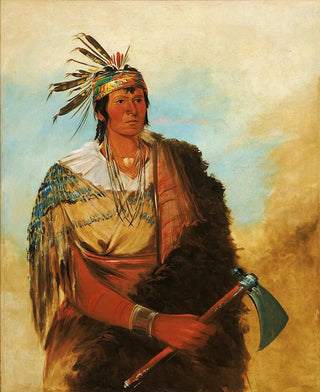Painting Go-To-Kw-Ph-Ah stands out as a distinguished brave - George Catlin | Art print


View from behind

Frame (optional)
George Catlin's artwork "Go-To-Kw-Ph-Ah" stands out as a distinguished brave—an captivating introduction
The piece "Go-To-Kw-Ph-Ah" by George Catlin is much more than a simple artistic representation. It embodies a meeting between two worlds: that of the Indigenous peoples of North America and that of European explorers of the 19th century. Catlin, as an artist and ethnographer, skillfully captured not only the physical appearance of his subjects but also their cultural essence. The depiction of Go-To-Kw-Ph-Ah, a Native American chief, bears witness to a time when the identity and traditions of native peoples were at risk. Through this work, the viewer is invited to immerse themselves in a universe rich in meanings and emotions, where every detail is charged with history.
Style and uniqueness of the work
Catlin's style is distinguished by its realistic approach and attention to detail. His portraits are imbued with an intensity that goes beyond mere visual reproduction. The color palette, often vibrant, highlights the features and ornaments of the characters, while the carefully studied composition creates an immediate connection with the viewer. In "Go-To-Kw-Ph-Ah" the chief's expression, both proud and serene, evokes a profound dignity. Symbolic elements, such as feathers and jewelry, are not merely decorative but carry strong meaning, reflecting the culture and values of his people. This art print stands out for its ability to transcend time, offering a poignant glimpse into a reality often overlooked.
The artist and his influence
George Catlin, born in 1796, dedicated his life to documenting Native American cultures through his paintings. Traveling across the United States, he met many chiefs and tribes, striving to preserve their image and heritage at a time when colonial expansion threatened their existence. His work had a significant impact on the perception of Indigenous peoples, presenting them in a new light, far from the stereotypes often conveyed. Catlin also played a key role in raising public awareness about cultural conservation issues.

Matte finish

View from behind

Frame (optional)
George Catlin's artwork "Go-To-Kw-Ph-Ah" stands out as a distinguished brave—an captivating introduction
The piece "Go-To-Kw-Ph-Ah" by George Catlin is much more than a simple artistic representation. It embodies a meeting between two worlds: that of the Indigenous peoples of North America and that of European explorers of the 19th century. Catlin, as an artist and ethnographer, skillfully captured not only the physical appearance of his subjects but also their cultural essence. The depiction of Go-To-Kw-Ph-Ah, a Native American chief, bears witness to a time when the identity and traditions of native peoples were at risk. Through this work, the viewer is invited to immerse themselves in a universe rich in meanings and emotions, where every detail is charged with history.
Style and uniqueness of the work
Catlin's style is distinguished by its realistic approach and attention to detail. His portraits are imbued with an intensity that goes beyond mere visual reproduction. The color palette, often vibrant, highlights the features and ornaments of the characters, while the carefully studied composition creates an immediate connection with the viewer. In "Go-To-Kw-Ph-Ah" the chief's expression, both proud and serene, evokes a profound dignity. Symbolic elements, such as feathers and jewelry, are not merely decorative but carry strong meaning, reflecting the culture and values of his people. This art print stands out for its ability to transcend time, offering a poignant glimpse into a reality often overlooked.
The artist and his influence
George Catlin, born in 1796, dedicated his life to documenting Native American cultures through his paintings. Traveling across the United States, he met many chiefs and tribes, striving to preserve their image and heritage at a time when colonial expansion threatened their existence. His work had a significant impact on the perception of Indigenous peoples, presenting them in a new light, far from the stereotypes often conveyed. Catlin also played a key role in raising public awareness about cultural conservation issues.
12,34 €






